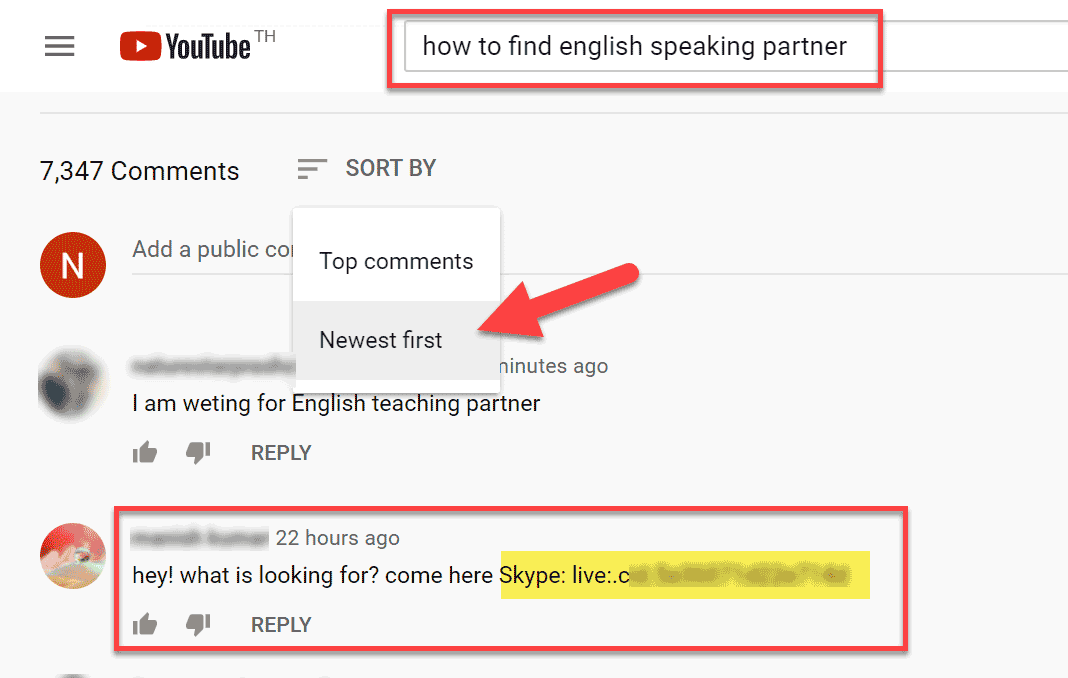
Want to practice speaking English but don’t know how?
You’ve come to the right place.
Here are 6 best exercises to practice your English conversation skills.
Basic exercises:
- Exercise #1: Imitate native speakers
- Exercise #2: Memorize short speeches
- Exercise #3: Practice with Q&A lessons
Advanced exercises:
- Exercise #4: Listen & express key ideas
- Exercise #5: Talk about random topics
- Exercise #6: Talk to real people
Do you know what’s great about these exercises?
Only the last exercise (#6) requires a speaking partner. But you can practice the other ones by yourself, at home, using English material you can find online for free!
English Speaking Practice:
Basic Exercises
Do you have these problems?
- You speak English in short phrases and broken sentences.
- You have trouble making complete, grammatical sentences.
- You have limited speaking vocabulary.
If so, you’ll love the 3 beginner-friendly exercises in this section.
Let’s discuss the first one.
Exercise #1: Imitate Native Speakers

Here’s how to practice this exercise:
First, find a video recorded by a native speaker.
You can use a video where it’s just one person talking to the camera. (You can find millions of such videos on YouTube.)

Note: You can practice with audio recordings like podcasts or find material from other sources, but YouTube is my favorite source for practice material.
Now, play the video. As you listen, try to imitate (copy) the speaker. When the speaker says something, pause the video and repeat after the speaker word for word.
How to Imitate Long Sentences
If you think this practice is easy, let me assure you that it’s not.
Why? Because native speakers often use long and complex sentences.
Here’s an example:
“There are a lot of things that people in our team, including myself, say all the time that we really need to stop saying.”
The sentence above is pretty long and complex, isn’t it?
When you imitate native speakers, you’ll come across sentences like this a lot.
So, how do you imitate a sentence like this?
The key is to memorize a few words at a time.
Don’t wait until the speaker completes the whole sentence. (You won’t remember anything if you do that.) Instead, after a few words have been spoken, pause and repeat those words immediately.
Here’s an example:
- Native speaker: “There are a lot of things…”
- You: “There are a lot of things…”
- Native speaker: “…that people in our team, including myself…”
- You: “…that people in our team, including myself…”
- Native speaker: “…say all the time that we…”
- You: “…say all the time that we…”
- Native speaker: “…really need to stop saying.”
- You: “…that we really need to stop saying.”
You get the point, right? When imitating a native speaker, you should imitate a few words at a time. (Whenever you start to think, “I can’t remember no more,” that’s a good time to pause and repeat the words.)
When you reach the end of a sentence, you should try to recall the whole sentence out loud.

When you try to recall a long sentence, you probably won’t be able to do it well. Your sentence may not be 100% correct. You might forget some words.
This is normal. In this case, rewind back to the beginning of the sentence and imitate it again.
How many times should you repeat? Do it until you can recall the sentence (almost) perfectly.
After that, continue the video and move on to the next sentence.
And that’s it! That’s how you practice imitating native speakers.
Does This Practice Really Work?
Yes, it does.
I’ve been using this method to improve my spoken English for a long time, with excellent results.
Some people may think this practice is not effective because all you do is repeat after someone like a parrot. There’s no thinking involved.
But the practice is not as easy as it seems. It requires you to recall long sentences from memory. Which can be quite difficult to do (especially for beginners).
And if you think your spoken English is too advanced for this exercise, don’t worry. You can practice the other exercises instead.
Exercise #2: Memorize Speeches

This practice is similar to the first one (but harder).
Just like the first exercise, you need a video or audio recording.
Here’s how to do it:
- Memorize the first 20 – 40 seconds of the video (or audio recording).
- Speak out loud the part you have memorized.
- Move on to the next 20 – 40 seconds.
Let’s get into the details.
Why Memorize 20 – 40 Seconds at a Time?
According to research on learning and skill development, for a practice exercise to be effective, it should not be too easy or too difficult.
Memorizing less then 20 seconds of something is too easy. (And it will be too similar to the first exercise.)
On the other hand, memorizing more than 40 seconds is too difficult. Forty seconds may not sound like much, but you can actually say a lot of stuff during that time frame.
So, I think 20 – 40 seconds seems to be the sweet spot — the optimal range for the practice to be effective.
How to Memorize
You can memorize the speech however you want. Just do what feels natural and convenient to you.
Here are some ideas:
- Listen to the part and repeat after the speaker over and over again.
- Write the words down on paper and read them out loud.
Once you’re confident that the part is ingrained in your memory, pause the clip. Put the transcript (if any) away where you can’t see. And speak the memorized words from memory.
How to Recite The Memorized Words
As you say the words aloud from memory, try to “feel” the meaning. Put some emotion into it.
Don’t recite the words mechanically like a robot. Be emotionally invested in what you’re saying.

Act as if you were the original speaker or pretend like you’re an actor practicing your lines for a movie.
What if you forget some words or details?
Naturally, you will NOT be able to say the memorized lines perfectly. That’s normal. If you can be 70 – 90% accurate, that’s probably good enough.
If you do worse than that, you can try to memorize that part again. (You’ll do better this time.)
Exercise #3: Practice with Q&A Speaking Lessons
Q&A means question and answer.
Watch the video below to learn how Q&A lessons work.
As shown in the video, here’s how these lessons work:
- The teacher asks a question.
- You answer the question out loud.
- The teacher states the correct answer.
- If your answer was incorrect, you pause the lesson and repeat the correct answer.
This is an excellent way to practice speaking English.
Unlike the first two exercises, this one is quite interactive.
Instead of mindlessly copying natives, you have to “think” and come up with correct answers.
And because the lessons give you instant feedback, you can fix your mistakes immediately.
Other than forming statements in English, these lessons can help you practice forming questions as well.
This is great because many English students have trouble asking questions in English.
If you want to try these Q&A lessons, go to this page to download two sample lessons.
Q&A lessons aren’t free because it costs time and money to make them. So if you don’t want to spend money, focus on the other speaking exercises.

Congratulations, you’ve learned the first three ways to practice speaking English.
These exercises are effective in improving “basic” speaking skills such as:
- Your English pronunciation
- The ability to form proper sentences in English
- Your speaking vocabulary (words you can use in spoken English)
The exercises can be used by students at all levels: beginner, intermediate, or advanced.
However, they are particularly beneficial to beginners, who seriously lack the fundamental speaking skills mentioned above.
So if you’re just getting started, these three exercises will be your secret weapons for reaching an intermediate level.
If so, enter your email address below:
English Conversation Practice:
Advanced Exercises
In the previous section, we discussed exercises designed to improve basic speaking skills (pronunciation, sentence structure, vocabulary).
In this section, you’ll learn exercises that target “high-level” conversation skills such as:
- Your ability to express ideas clearly
- Your speed at “finding the right words” during a conversation
- Your social skills like making small talk
If want to speak fluent English, get ready.
The following practices will take your spoken English to that level!
Exercise #4: Listen and Express Key Ideas

Do you have trouble expressing your thoughts in English?
If so, this advanced practice is for you.
Here are the steps:
- Listen to a conversation of native speakers.
- As you listen, don’t try to memorize the words (or small details). Instead, focus on the main point(s) of the conversation.
- After 20 – 40 seconds, pause the material.
- Try to communicate the point(s) in your own words.
Unlike the previous exercises, here you don’t memorize individual words. Instead, you memorize the meaning — the essence of the conversation.
And when you try to convey the information, you don’t try to use the same words the original speaker used. You use your own words.
Now, if you feel like this practice seems difficult, you’re right.
In the beginning, it’ll be extremely hard for you to practice this exercise.
You will have trouble expressing ideas in a clear and logical manner. Quite often you will say things that don’t make sense.
This is normal. (This is an advanced speaking practice after all.)
Because of the difficulty of this exercise, I suggest that you attempt to express the same point several times, without re-listening to the original part.
In other words, repeat the 4th step several times.
The first attempt will be the worst. (You won’t make much sense.) But you’ll do a little better the second time, and even better the third time.
Don’t think or worry about making grammatical mistakes. There’s no need to be perfect.
Keep trying until you feel like what you’re saying starts to make some sense. After that, move on to the next part.
Exercise #5: Talk About Random Topics

This exercise is similar to the previous one.
The difference is that you don’t need any English material at all.
All you need to do is think of something (a random topic) to talk about in English.
Examples of things to talk about:
- What’s on your mind at the moment
- What you did yesterday
- Your educational background
- Your favorite hobbies and why you enjoy them
- Your favorite films and TV shows and the reasons you love them
This practice requires quick thinking. You have to quickly search for words to convey your thoughts.
It also requires some creativity. Quite often you won’t be able to find the perfect words to use, so you have to resort to using simpler or similar words.
For example, consider this sentence:
“I majored in computer engineering in college.”
What if you don’t know the word “major” or the term “computer engineering?” How do you communicate the same message?
If that’s the case, you may have to “simplify” it by saying something like:
“I studied how to build software in college.”
This is a very demanding exercise.
But the ability to talk about random things without preparation can be beneficial in situations like job interviews or when meeting new people.
The Limitations of This Practice
Talking to yourself seems like a good way to practice spoken English.
But there are two big problems with it.
Problem #1: Incorrect usage of English
Right now you probably make a lot of mistakes when speaking English. Maybe you use some words incorrectly, or you speak in broken sentences and weird pronunciation.
Now imagine that you start talking to yourself in English every day. (And that’s the only speaking practice you do.)
What do you think will happen after a few months?
Here’s what will happen: you’ll be able to speak English faster, but your spoken English will be difficult to understand because you don’t speak English like native speakers. (You’ve developed your own way of talking in English.)
This misuse or corruption of the English language is called Engrish (wrong spelling). It happens to people who have limited exposure to proper English.
Problem #2: You’re NOT learning new things
For the previous exercises, you’re required to practice with English material or Q&A lessons, so you’re constantly exposed to new vocabulary.
But when you’re just talking to yourself, you’re not getting any new input. Which means you aren’t learning any new vocabulary.
Because of these two disadvantages, talking to yourself should not be your “main” speaking practice.
It’s okay to practice this way from time to time. But you should spend more time on exercises that allow you to correct your mistakes and learn new things. (Exercises #1, #2, and #3 are great for that.)
Exercise #6: Talk to Other People (Online)

So far, we’ve discussed only speaking exercises that you can do alone.
Self-practice is awesome because you don’t have to rely on other people. This make it possible to practice speaking English on a consistent basis.
However, practicing with a partner has one advantage over self-practice; it lets you practice your social skills.
When you talk to people, you learn how to make eye contact, how to use proper body language and facial expressions, how to listen attentively.
Most importantly, you get to practice making small talk in English.
What is Small Talk?
Small talk is a polite conversation about unimportant matters.
Examples of how to start a small talk:
- “What are you doing this weekend?”
- “What are some of your favorite movies?”
- “Do you play any musical instrument?”
- “Where are you from?”
In real life, there are some situations that require us to make small talk. We do it when we want to build rapport with someone, or when we run into a friend or acquaintance.

Making small talk is a nice social skill to have. Unfortunately, you can’t improve this skill by practicing alone.
To develop this skill, you need to talk to real people.
Where to Find a Speaking Partner
There are many English students who are looking for practice partners online.
And you can find them pretty easily.
First, go to YouTube and search for terms like
- How to practice speaking English
- How to find English speaking partner
Click on a video thumbnail in the search results, and go down to the comments section.
If you sort the comments by date (so newest comments are shown first), you may see a few comments from people who are looking for practice partners.

Simply add their contact ID on whatever chat software they’re using.
Once you’ve added the contact, send them a quick message to let them know why you added them.
Hi. I’m Natee. I saw your comment on YouTube about finding a speaking partner. I want to practice my spoken English too! I added you in case you’d like to practice speaking English with me.
The Limitations of This Practice
Finding a speaking partner is not difficult.
Buy that’s only the beginning.
Once you begin to practice with your partner, you’ll run into annoying problems such as:
- Your partner doesn’t show up on time.
- You want to practice for 30 minutes. But after talking for 5 minutes, you and your partner don’t know what else to say.
- Your partner is not serious about improving his spoken English. He disappears after a few days.
- Your partner’s spoken English is very poor. He doesn’t talk much. You feel like you’re talking to yourself.
- Your partner’s spoken English is much better than yours, and she talks a lot. You feel like you’re practicing listening skills, not speaking skills.
- The connection is bad. You have to keep re-connecting to the service.
My point is that relying on other people can be troublesome.
So just like the previous exercise (talking to yourself), I suggest you use this method as an “additional” practice.
It’s okay to chat with people online every now and then to practice social skills. But you should spend the majority of your time on the basic exercises.
When & How to Practice These Exercises?

You have learned six different ways to practice speaking English.
But which exercises should you practice? Should you do them all or select a few?
Well, all of these exercises are good. You can try each of them and see which ones work best for you.
That said, if you want specific advice, let me give you some.
Advice for Beginners
As a beginner, your priority is to master basic speaking skills such as pronunciation, sentence construction, and speaking vocabulary.
So you should focus on Exercises #1, #2 and #3. They’re excellent at improving those skills.
You can practice only one exercise for an entire week or month before switching to another one, or you can switch to a different exercise daily. It’s up to you.
Try to practice at least 15 – 45 minutes each day.
This amount of practice is for busy and average people. But if you have a lot of free time, feel free to practice more.
The more time you spend practicing, the faster you’ll improve!
Advice for Intermediate/Advanced Speakers
Even if your spoken English is intermediate or quite advanced, you still need to keep improving the basic speaking skills mentioned earlier.
Particularly, you need to keep expanding your speaking vocabulary.

Why? Because being able to use a lot of words in conversations is key to speaking fluent English. (The more words you can use, the better you are at expressing yourself.)
But at the same time, you should also start developing high-level conversation skills (like the ability to express ideas in a clear, logical manner).
So the best practice routine for you is a combination of both basic and advanced exercises.
For the sake of simplicity, I suggest that you pick one basic exercise and one advanced exercise to do.
For example, you may choose these two:
- Exercise 1: Imitate native speakers
- Exercise 4: Listen and express ideas
You can practice both exercises on the same day, or you can alternate between them.
However, there’s no need to spend an equal amount of time on each exercise. For instance, you can practice the basic exercise five days a week while doing the advanced exercise only two days a week.
The possibilities are endless. Feel free to experiment and see what works best for you.
Thanks for reading. I hope you find these practice ideas useful.
Note that you don’t have to practice the exercises exactly as I described.
The truth is, the way I practice my English speaking skills is quite random. I don’t follow a set of clear, specific steps myself.
So there’s no need to follow all the steps perfectly. Feel free to modify the exercises however you want.
For more in-depth details on improving your spoken English, I suggest that you also read my guide on how to speak English fluently.
The guide covers topics such as:
- The right way and the wrong way to learn spoken English
- Two additional activities you should do to improve your speaking skills (other than speaking practice)
- How to ensure that you’ll actually become fluent in English
- etc.
I encourage you to read that guide. You’ll gain a better understanding on how to improve your English conversation skills more effectively.
Want to practice your spoken English?
If so, I have a premium English speaking course for you.
Click the button above the learn more.

